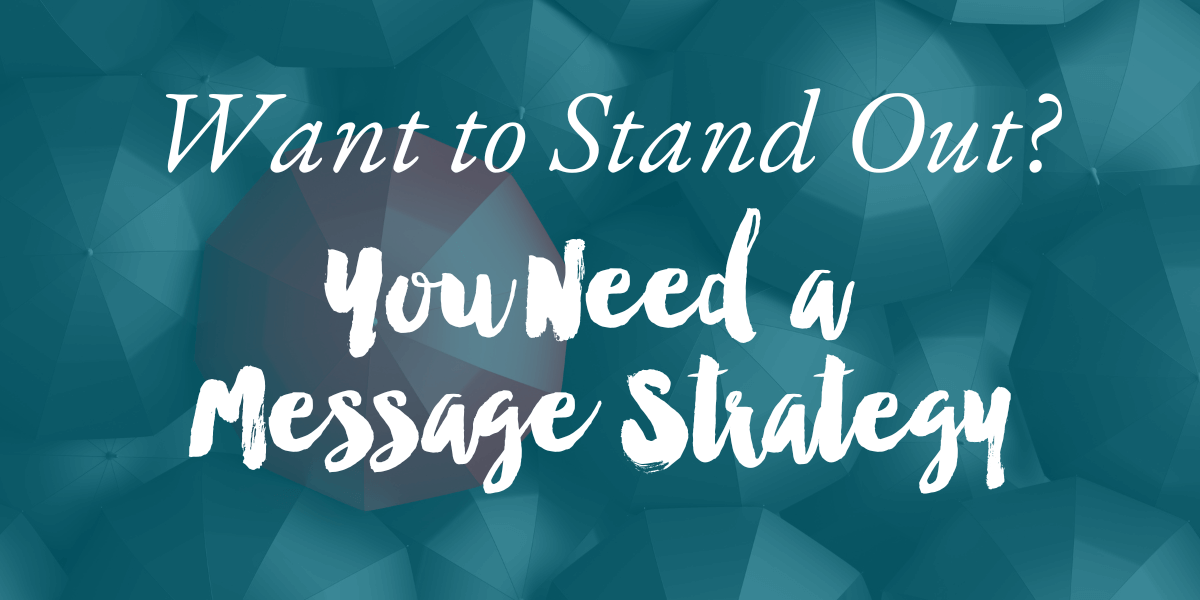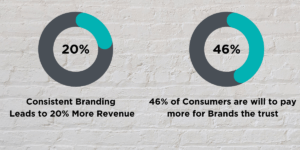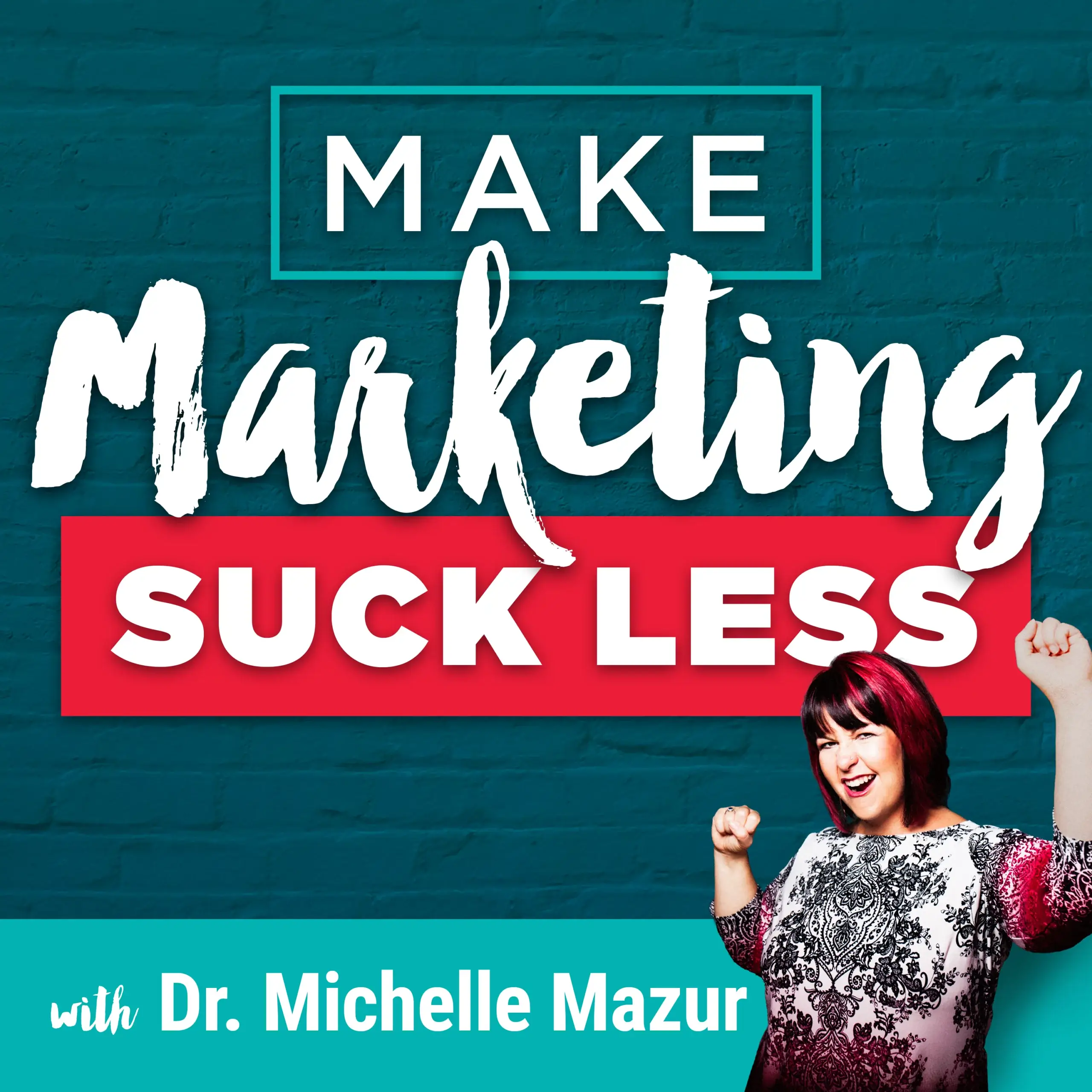Make Marketing Suck Less
Want to Stand Out In Your Industry? You Need a Messaging Strategy
By Michelle Mazur > April 19, 2023
Filed Under 3 Word Rebellion

There’s a lot of confusion about what messaging and messaging strategy is.
Over the years, I’ve heard messaging defined as:
- Your elevator pitch
- A content plan
- Developing your offer and pricing your offer
- A unique selling proposition
- The copy on your website
These definitions are all a bit correct and missing some core pieces that make your marketing strategy effective for your business.
Since consistency with your brand messaging can increase revenue by 20% (Marq, 2021), let’s clear up the confusion between messaging, marketing, and copywriting.
Table of Contents
- 1 What is the difference between Messaging, Copywriting, and Marketing?
- 2 What are the Core Components of a Messaging Strategy
- 3 How Do You Know If Your Messaging Strategy Works?
- 4 What are the Key Benefits of Creating a Brand Message Strategy?
- 4.1 #1. Consistent Branding and Brand Messaging Can Increase Your Revenue by 20%
- 4.2 #2. Boost Brand Awareness By Being Known for Something.
- 4.3 #3. More Opportunities for Visibility
- 4.4 #4. Clients Show Up Ready to Work with You
- 4.5 #5. Spend Less Time Marketing and More Time Doing What You Love (Working with Your Clients)
- 5 How do You Know If Your Business is Ready for a Messaging Strategy
- 6 My Approach to Creating a Messaging Strategy That Stands Out
What is the difference between Messaging, Copywriting, and Marketing?
Let’s start by defining what each of these foundational pieces of business is.
Messaging
A strategy and system comprising key messages you want to share consistently, positioning, beliefs shifts, and calls to action.
All your messaging should lead the right customer to your services and products. Its main job is persuasion. Messaging is an overall communication strategy that informs your copy and marketing.
Marketing
Refers to any action your business takes to attract an audience and potential leads to your product or services through persuasive messaging. Marketing amplifies your messaging.
Copywriting
The words you use and how you say them are also a sales conversion tool. Copywriting produces a physical deliverable for your website, email, and other business collateral.
The shorthand way that I remember the difference is:
- Messaging is what you want to say
- Copywriting is how to say it on the page
- Marketing amplifies your message
Before you hire a copywriter or a marketer, you need to craft your business’s messaging strategy.
What are the Core Components of a Messaging Strategy
From discovery to the deal, an excellent messaging strategy ensures that your business is consistently on message as your potential client moves through your customer journey.
Your strategy should include the following:
- Positioning & Differentiation: Your message should communicate how your business differs and stands out from your competition.
- Client Empathy Map: Specific messaging that speaks to your right-fit client and empathizes with their struggle.
- Client/Customer Journey: Key messages that turn strangers into clients by shifting their beliefs and positioning your offer as a solution to their problems.
- Brand Stories: Build an emotional connection and foster know, like, and trust between your business and your client.
Once you create your messaging strategy, the next question is, how do you know if it works?
Want a new way to communicate how your business is different? Check out the 3 Word Rebellion free audio workshop that creates a one-of-a-kind message that positions your business in a category of one.
How Do You Know If Your Messaging Strategy Works?
Clearly, your brand's messaging powers your marketing and copywriting, but how do you know if it’s working?
Big companies with large audiences (and budgets) will hire market research firms for extensive messaging studies or A/B testing.
Most expert-driven small businesses don’t have the time, money, or audience to do this type of research, so you’ll need to rely on more qualitative measures.
Let’s talk about the best indicator and the worst indicator of the success of your marketing messaging.
The Best Indicator Your Marketing Messaging Works: Sales
The best indicator that your message is indeed working is sales.
- Are you making the sales you want to make?
- Are you closing the deals you want to close?
- When people show up on sales calls, are they ready to work with you, and are they just seeing if it's a fit?
- Are people filling out your intake form regularly?
If you answer yes, I have enough sales and getting enough leads, then great news, your message is working the way it should.
My client, registered dietician Cassie Christopher experienced this firsthand. Here’s what she said:
“I just did a podcast interview yesterday, and before I did it, the gal was like, “Oh, I read your website, and I see I have the problem you solve.” By the end, I ended up booking a sales call with her. It was a short, quick one because she already knew everything about what I do.”
If the answer is no to making sales, your messaging is not doing its job.
As a reminder, the job of your message is to persuade and turn someone who doesn't know you at all into a client. Your message should be about leading people to your work. It should be about persuasion, making that argument.
Even though it’s the best indicator, I still see business owners getting confused because of the worst indicator of marketing messaging success.
The Worst Indicator That Your Marketing Messaging Works: Social Media
It’s easy to think that if you can build a huge social media following, your message is working, and sales are imminent.
Once upon a time, back in the good old days of 2019, there was an Instagram influencer with a massive 2.6 million people who hung on her every word. The Instagram influencer wanted her own clothing line and would start with a t-shirt.
She needed 36 people to buy a t-shirt, and she’d produce the first run. This means she needed a conversion rate of 0.00001385.
But she couldn't. She couldn't get 36 of her followers to buy a t-shirt.
So what's going on there?
A big audience does not equal an audience of buyers!
Social media is a terrible indicator that your message works because it casts the widest net possible, and your audience may not be filled with buyers.
They might be following you because they like the look of your account. They saw your inspirational post and said, “Wow, this person is great.”
But at the end of the day, they weren't interested in the problem your business solves.
For micro business owners, sales will always be the ultimate test for whether or not your brand message strategy works.
What are the Key Benefits of Creating a Brand Message Strategy?
There are five significant benefits when you create a brand message strategy that makes it worth investing time, money, and energy.
#1. Consistent Branding and Brand Messaging Can Increase Your Revenue by 20%
It’s no surprise that your clients are looking for the same experience of your business, whether they interact with you on social media, hear about your business on a podcast, or visit your website.
In a study conducted by Marq, they found that having a consistent brand can boost revenue by 20%. Why?
When you’re consistently on message, your audience knows what you stand for and can trust you’ll deliver. In fact, according to a Salisfy.com study, 46% of consumers are willing to pay more for a brand they trust!

#2. Boost Brand Awareness By Being Known for Something.
Starbucks is known for coffee. Amazon is known for its massive variety of products. Nike is known for its athletic shoes. What is your business known for?
A message strategy helps you create a message around that “thing” your business does and then develops the key messages you constantly repeat to be known for your work.
#3. More Opportunities for Visibility
When your business is known for something, more opportunities for visibility come your way.
Whether it’s podcast interviews, media appearances, speaking on stages, or teaching in masterminds or conferences, you need a message worth sharing and repeating to land those opportunities.
Better yet, when your brand message strategy is so clear and compelling, those opportunities start coming to you!
#4. Clients Show Up Ready to Work with You
Your message strategy is all about persuasion. When you’ve got it dialed in, your clients show up ready to work with you.
They understand the problem you solve, how it benefits them, and how you work with people.
Sales become easy when all of your marketing messaging leads people to your work.
#5. Spend Less Time Marketing and More Time Doing What You Love (Working with Your Clients)
None of the expert business owners I work with started their businesses so they could market their expertise. (Most hate marketing).
Once you’ve got your messaging strategy dialed in, you know what to say, what kind of content to create, and what marketing assets to build over time, so you get to spend less time on marketing because your marketing is far more effective.
How do You Know If Your Business is Ready for a Messaging Strategy
If you’ve read this far, you might think that messaging strategy work is something your business should invest in at some point.
But how do you know if your business is ready to go all-in on creating a messaging strategy? Here are the tell-tale signs:
#1. A Proven Offer that Gets Results
A proven offer doesn’t mean that you’ve made millions of dollars but that you’ve had a handful of clients and customers go through your process and get results.
Your clients love the results they get, but it leaves you wondering, “If I’m so amazing at what I do, why don’t more people know about me?”
Messaging strategy is the right step if you’ve got a great offer but need more people to know about it.
#2. An Over-Reliance on Word of Mouth/Referral Marketing
Word of mouth is excellent. Referrals build entire businesses. Referral marketing is also erratic and unreliable.
You never know when that referral is coming in, and you have to rely on your client being able to describe the work you do accurately.
If you want more stability, you need more marketing systems than referrals, which means you need a message to power your marketing.
#3. Increase Your Reach and Impact of Your Work
Whether you want to start a group program or reach more people who need your work, you’re tired of being the overlooked expert.
Deep down, you know your business could reach and help more people.
It’s going to take marketing to make that happen. Some of my clients know that they have books in them or want to be speaking, but they need an audience to make that happen.
If you feel that you need to reach more people and that your work deserves to be seen by more of the right people, you’ll need a messaging strategy to make that happen.
My Approach to Creating a Messaging Strategy That Stands Out
In the 3 Word Rebellion Messaging & Marketing Intensive, the goal is to powerfully communicate the value your business creates, whether marketing to one person or a million people.
When you leave this program, you'll have a whole new way to talk about what you do and understand the key messages to use in your marketing and sales. Plus, you’ll be more confident when sharing your messaging.
The deliverables include:
- A 3 Word Rebellion to Differentiate Your Business: These three words will call in your audience, make them curious about what you’re up to, and get them talking about your message so that you get known! It also positions you as the only person that does what you do.
- Client Empathy Map: Gain deeper insights into what your clients are feeling, doing, and saying so your message feels like you’re reading their minds.
- The Client Decision Journey: Key messages for your content that build an argument for your work and turn strangers into clients. (this includes at least 20+ ideas for your content marketing)
- “Why to Buy” Message/Program Promise:: The most compelling reason to do business with you and decide to say yes to working with you.
- Conversion Strategy: Understand the critical belief shifts and CTAs for each step of your customer journey
- “Why to Buy” Message/Program Promise:: The most compelling reason to do business with you and decide to say yes to working with you.
- Signature Brand stories to support your rebellion:: We’ll cull and develop at least three stories (or more) that connect to the emotions of your people and give the audience a compelling reason to believe in your message.
- A marketing strategy to launch your 3 Word Rebellion: All this messaging work does no one any good if it dies in a Google document. We’ll create a simple marketing strategy so you know exactly HOW to use this message in your marketing.
Finally, we’ll create a Brand Message Guide. This documents your message in one place, so you can access it when you need to generate content, prepare for a podcast interview, or create a keynote speech.
Ready to create your signature brand messaging strategy?
Your messaging strategy is critical to standing out in your industry and making your marketing efforts pay off.
The sooner you tackle your messaging strategy for your business, the sooner you’ll boost brand awareness, grow your audience and have more of the right clients book your business, which means your business sees more revenue!
Want more messaging and marketing insights to stand out in your industry?
Create Your One-of-a-Kind Message
Your 3 Word Rebellion is the Key to Growing Your Business & Impact






